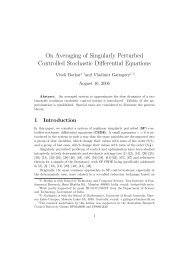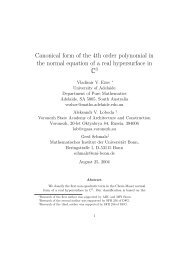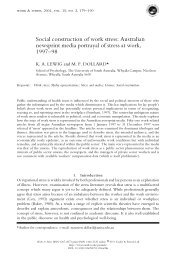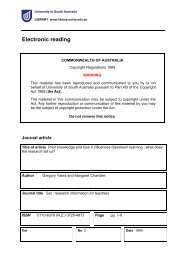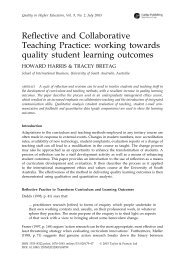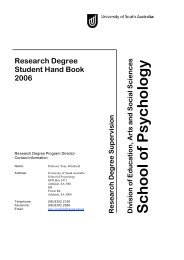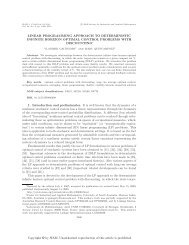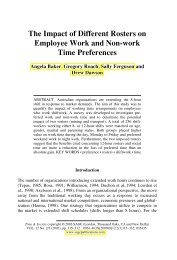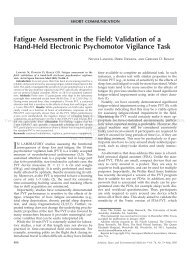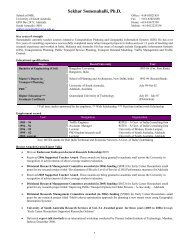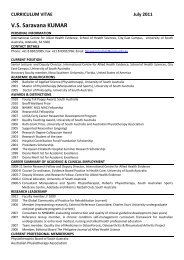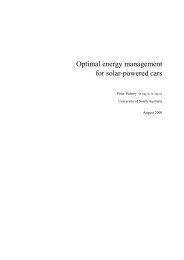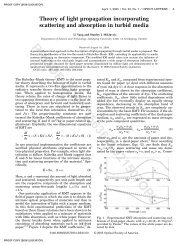284 de Jonge, Dollard, Dormann, Le Blanc, and Houtmandently of changes in job demands (Karasek, 1979). <strong>The</strong> present study shows,however, th<strong>at</strong> effects of altering the amount of control seem to depend on theparticular job demands under investig<strong>at</strong>ion (i.e., workload, physical demands,or emotional demands). In other words, the kind of job demands th<strong>at</strong> will bepotentially stressful or challenging has to be considered before implementingany intervention. This means th<strong>at</strong>, for human service workers, emotional demandsare most important in the model. Further, this study has shown th<strong>at</strong> agood balance between demands and control might result in s<strong>at</strong>isfying and challengingjobs.In conclusion, the reported findings add to accumul<strong>at</strong>ing evidence of adverseeffects on psychological well-being jointly produced by both job demandsand job control. This study has shown th<strong>at</strong> different types of job demandsare—in combin<strong>at</strong>ion with job control—important in predicting both positiveoutcomes (i.e., job s<strong>at</strong>isfaction, job challenge) and neg<strong>at</strong>ive outcomes (i.e., emotionalexhaustion, psychosom<strong>at</strong>ic health complaints). Finally, using and comparingwell-defined occup<strong>at</strong>ional groups seem to contribute to higher research qualityin testing the DCM, and also give support to the choice of the DCM in jobstress research.REFERENCESAiken, L. S., & West, S. G. (1991). Multiple regression: Testing and interpreting interactions.Newbury Park, CA: Sage Public<strong>at</strong>ions.Andries, F., Kompier, M. A. J., & Smulders, P. G. W. (1996). Do you think your health and safetyare <strong>at</strong> risk because of your work? A large European study on psychological and physical workdemands. Work and Stress, 10, 104–118.Begley, T. M., & Czajka, J. M. (1993). Panel analysis of the moder<strong>at</strong>ing effects of commitment onjob s<strong>at</strong>isfaction, intent to quit, and health following organiz<strong>at</strong>ional change. Journal of AppliedPsychology, 78, 552–556.Bentler, P. M., & Bonett, D. G. (1980). Significance tests and goodness of fit in the analysis ofcovariance structures. Psychological Bulletin, 88, 588–606.Bollen, K. A. (1989). Structural equ<strong>at</strong>ions with l<strong>at</strong>ent variables. New York: Wiley.Breaugh, J. A. (1985). <strong>The</strong> measurement of work autonomy. Human Rel<strong>at</strong>ions, 38, 551–570.Cordery, J. (1997). Reinventing work design theory and practice. Australian Psychologist, 32, 185–190.Dirken, J. M. (1969). Arbeid en stress [Work and stress]. Groningen: Wolters Noordhof.van der Doef, M., & Maes, S. (1998). <strong>The</strong> Job <strong>Demand</strong>-<strong>Control</strong>(-Support) <strong>Model</strong> and physicalhealth outcomes: A review of the strain and buffer hypotheses. Psychology and Health, 13,909–936.van der Doef, M., & Maes, S. (1999). <strong>The</strong> Job <strong>Demand</strong>-<strong>Control</strong>(-Support) <strong>Model</strong> and psychologicalwell-being: A review of 20 years of empirical research. Work and Stress, 13, 87–114.Dollard, M. F. (1997). Work stress: Conceptualis<strong>at</strong>ions and implic<strong>at</strong>ions for research methodologyand workplace intervention (Doctoral dissert<strong>at</strong>ion). Whyalla, South Australia: Work and StressResearch Group.Dollard, M. F., & Winefield, A. H. (1998). A test of the <strong>Demand</strong>-<strong>Control</strong>/Support <strong>Model</strong> of workstress in correctional officers. Journal of Occup<strong>at</strong>ional Health Psychology, 3, 243–264.
<strong>Demand</strong>-<strong>Control</strong> <strong>Model</strong>285Dunnette, M. D. (1998). Emerging trends and vexing issues in industrial and organis<strong>at</strong>ional psychology.Applied Psychology: An Intern<strong>at</strong>ional Review, 47, 129–153.Fox, M. L., Dwyer, D. J., & Ganster, D. C. (1993). Effects of stressful job demands and control onpsychological and <strong>at</strong>titudinal outcomes in a hospital setting. Academy of Management Journal,36, 289–318.Frese, M. (1989). <strong>The</strong>oretical models of control and health. In S. L. Sauter, J. J. Hurrell Jr., &C. L. Cooper (Eds.), Job control and worker health (pp. 107–128). Chichester: Wiley & Sons.Frese, M. (1999). Social support as a moder<strong>at</strong>or of the rel<strong>at</strong>ionship between work stressors andpsychologicial dysfunctioning: A longitudinal study with objective measures. Journal of Occup<strong>at</strong>ionalHealth Psychology, 4, 179–192.Frese, M., & Zapf, D. (1988). Methodological issues in the study of work stress: Objective vssubjective measurement of work stress and the question of longitudinal studies. In C. L.Cooper, & R. Payne (Eds.), Causes, coping and consequences of stress <strong>at</strong> work (pp. 375–411).Chichester: Wiley and Sons.Frese, M., & Zapf, D. (1994). Action as the core of work psychology: A German approach. InH. C. Triandis, M. D. Dunnette, & L. M. Hough (Eds.), Handbook of industrial and organiz<strong>at</strong>ionalpsychology (Vol. 4, pp. 271–340). Palo Alto, CA: Consulting Psychologists Press.Ganster, D. C., & Fusilier, M. R. (1989). <strong>Control</strong> in the workplace. In C. L. Cooper, & I. T.Robertson (Eds.), Intern<strong>at</strong>ional review of industrial and organiz<strong>at</strong>ional psychology (pp. 235–280). Chichester: Wiley & Sons.Hochschild, A. (1983). <strong>The</strong> managed heart. Berkeley: University of California Press.Hockey, G. R. J. (2000). Work environments and performance. In N. Chmiel (Ed.), An introductionto work and organiz<strong>at</strong>ional psychology: A European perspective (pp. 206–230). Oxford: BlackwellPublishers.Houtman, I. L. D., Smulders, P. G. W., & Klein Hesselink, D. J. (Eds.) (1999). Trends in arbeid1999 [Trends in work 1999]. Amsterdam: NIA’TNO.Jaccard, J. R., Turrisi, R., & Wan, C. K. (1990). Interaction effects in multiple regression. NewburyPark, CA: Sage Public<strong>at</strong>ions.Jones, F., Bright, J. E. H., Searle, B., & Cooper, L. (1998). <strong>Model</strong>ling occup<strong>at</strong>ional stress andhealth: <strong>The</strong> impact of the demand-control model in academic research and on workplace practice.Stress Medicine, 14, 231–236.Jones, F., & Fletcher, B. (C.) (1996). Job control and health. In M. J. Schabracq, J. A. M. Winnubst,& C. L. Cooper (Eds.), Handbook of work and health psychology (pp. 33–50). Chichester:Wiley & Sons.de Jonge, J. (1995). Job autonomy, well-being, and health: A study among Dutch health care workers(Doctoral dissert<strong>at</strong>ion). Maastricht, <strong>The</strong> Netherlands: D<strong>at</strong>awyse.de Jonge, J., Bosma, H., Peter, R., & Siegrist, J. (2000). Job strain, effort-reward imbalance andemployee well-being: A large-scale cross-sectional study. Social Science and Medicine, 50,1317–1327.de Jonge, J., & Kompier, M. A. J. (1997). A critical examin<strong>at</strong>ion of the <strong>Demand</strong>-<strong>Control</strong>-Support<strong>Model</strong> from a work psychological perspective. Intern<strong>at</strong>ional Journal of Stress Management, 4,235–258.de Jonge, J., Landeweerd, J. A., & Nijhuis, F. J. N. (1993). Constructie en validering van de vragenlijstten behoeve van het project ‘autonomie in het werk’ [Construction and valid<strong>at</strong>ion of thequestionnaire for the ‘job autonomy project’]. Studies bedrijfsgezondheidszorg nummer 9.Maastricht: Maastricht University.de Jonge, J., Mulder, M. J. G. P., & Nijhuis, F. J. N. (1999). <strong>The</strong> incorpor<strong>at</strong>ion of different demandconcepts in the Job <strong>Demand</strong>-<strong>Control</strong> <strong>Model</strong>: Effects on health care professionals. Social Scienceand Medicine, 48, 1149–1160.Jöreskog, K. G. (1993). Testing structural equ<strong>at</strong>ion models. In K. A. Bollen & J. S. Long (Eds.),Testing structural equ<strong>at</strong>ion models (pp. 294–316). Newbury Park, CA: Sage Public<strong>at</strong>ions.Jöreskog, K. G., & Sörbom, D. (1993). LISREL 8: User’s reference guide. Chicago: ScientificSoftware Intern<strong>at</strong>ional.Karasek, R. A. (1979). Job demands, job decision l<strong>at</strong>itude, and mental strain: Implic<strong>at</strong>ions for jobredesign. Administr<strong>at</strong>ive Science Quarterly, 24, 285–307.Karasek, R. A. (1998). <strong>Demand</strong>/<strong>Control</strong> <strong>Model</strong>: A social, emotional, and physiological approach to
- Page 2: 270 de Jonge, Dollard, Dormann, Le
- Page 6 and 7: 274 de Jonge, Dollard, Dormann, Le
- Page 8 and 9: 276 de Jonge, Dollard, Dormann, Le
- Page 10 and 11: 278 de Jonge, Dollard, Dormann, Le
- Page 12 and 13: 280 de Jonge, Dollard, Dormann, Le
- Page 14 and 15: 282 de Jonge, Dollard, Dormann, Le
- Page 18 and 19: 286 de Jonge, Dollard, Dormann, Le




